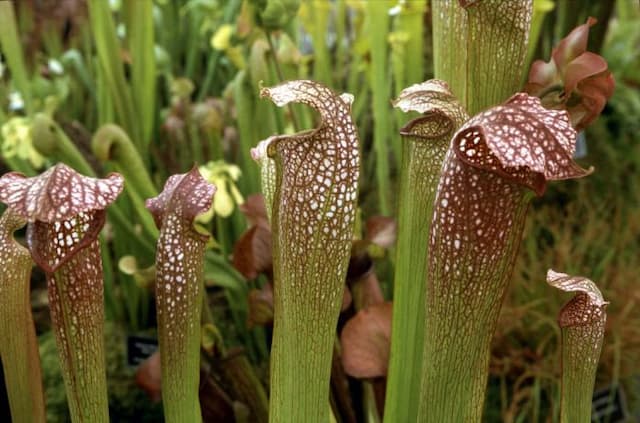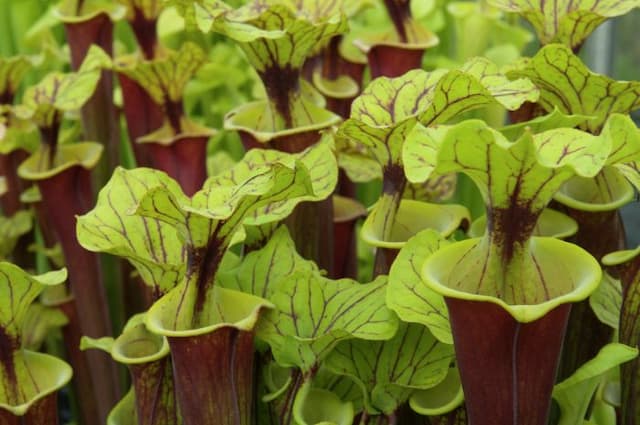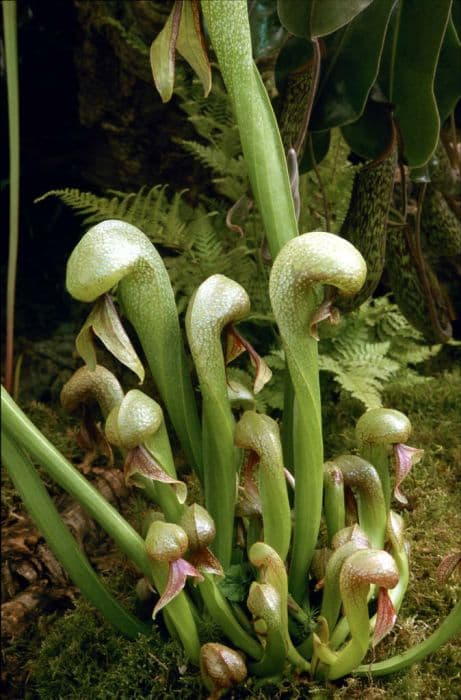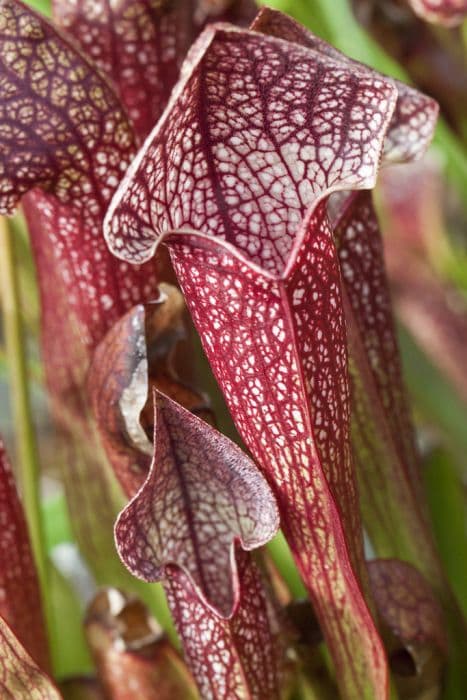White Pitcher Plant Sarracenia leucophylla

ABOUT
The White-Topped Pitcher Plant is a visually striking carnivorous plant named for its most distinctive feature: its elegant pitcher-shaped leaves. These leaves are tubular, with a hollow cavity, and are designed to trap and digest insects. The upper part of these specialized leaves is flared into a hood-like structure, which often displays dramatic contrasts of white with red veining, giving the plant its common name. This crest at the top of the pitcher often appears frilled or ruffled, adding to its ornateness. This plant produces two types of pitchers: the spring or early season pitchers that typically have more substantial white and red coloration and are produced at or near ground level, and the summer or late season pitchers that are taller and more slender with a higher proportion of green. The colors can be quite intense and are used to attract their prey into the trap. The inside of the pitcher is slippery and has downward-facing hairs causing insects to fall into the digestive fluids at the bottom of the pitcher. The White-Topped Pitcher Plant also produces flowers, which are borne on tall, individual stalks that rise above the pitchers. These flowers have a complex structure and can vary in color, usually shades of yellow or red. The flowers are umbrella-like in appearance, with numerous petals that hang downward, encircling the central reproductive parts of the flower which point upwards. This plant reflects a fascinating combination of beauty and functionality, with its elegant pitchers working as an effective trap for its sustenance, making it an alluring specimen for both cultivation and study in the wild. Its unique adaptation to nutrient-poor environments has led to an intriguing form that captivates the interest of botanists and enthusiasts alike.
About this plant
 Names
NamesFamily
Sarraceniaceae
Synonyms
Crimson Pitcher Plant, White Pitcher Plant, White Trumpets, Purple Trumpet-Leaf
Common names
Sarracenia leucophylla var. alba, Sarracenia leucophylla f. viridescens, Sarracenia drummondii, Sarracenia leucophylla var. drummondii, Sarracenia leucophylla var. heterophylla, Sarracenia mitchelliana, Sarracenia leucophyla
 Toxicity
ToxicityTo humans
The White Pitcher Plant is generally not considered toxic to humans. There is no significant evidence of toxicity upon ingestion, and the plant is not known to cause any severe symptoms in people.
To pets
The White Pitcher Plant is not commonly reported as toxic to pets. While not typically considered dangerous, ingestion of plant parts by pets should still be avoided. If a pet ingests a large amount, gastrointestinal upset could occur due to the unfamiliar plant matter.
 Characteristics
CharacteristicsLife cycle
Perennials
Foliage type
Deciduous
Color of leaves
Varies
Flower color
White
Height
1-3 feet (0.3-0.9 meters)
Spread
1-2 feet (0.3-0.6 meters)
Plant type
Herb
Hardiness zones
8
Native area
Southeastern United States
Benefits
 General Benefits
General Benefits- Ecological balance: Sarracenia leucophylla, commonly known as the white-topped pitcher plant, contributes to the ecosystem by trapping and digesting insects, thereby potentially controlling pest populations.
- Water management: It thrives in wetlands, playing a role in maintaining the health and stability of these important habitats.
- Ornamental value: With its striking white and red-patterned pitchers, it is often used as a unique and interesting ornamental plant in gardens and collections.
- Education and research: The plant is a subject of scientific research, providing insight into carnivorous plant mechanisms and evolutionary adaptations.
- Conservation: It serves as an indicator species for the health of its native habitats, thereby aiding in conservation efforts for wetland ecosystems.
- Biodiversity support: By existing in a niche environment, it adds to the biodiversity of its native area and offers a habitat for specific microorganisms.
 Medical Properties
Medical Properties- This plant is not used for medical purposes.
 Air-purifying Qualities
Air-purifying QualitiesThis plant is not specifically known for air purifying qualities.
 Other Uses
Other Uses- Decorative purposes: Sarracenia leucophylla, or the white pitcher plant, is often cultivated and grown in gardens and greenhouses for its striking appearance and unique pitcher-shaped leaves.
- Insect control: While primarily trapping insects for its own nutrition, the white pitcher plant can help reduce the population of unwanted pests in a garden setting.
- Photography and art: The unique look of the white pitcher plant makes it a popular subject for photographers and artists looking to capture the beauty of carnivorous plants.
- Education and research: This plant is used in educational settings to demonstrate various biological concepts such as adaptation, carnivorous feeding mechanisms, and ecosystem interactions.
- Scientific study: Researchers may study Sarracenia leucophylla to learn more about plant-insect interactions, co-evolution, and the chemistry of digestive enzymes in carnivorous plants.
- Terrariums and vivariums: The white pitcher plant is a suitable and attractive addition to terrariums and vivariums, providing visual interest and a natural method of insect control.
- Environmental indicators: The health and prevalence of white pitcher plants in the wild can serve as indicators for the health of their native ecosystems, particularly wetlands.
- Crafts and ornamentation: Pressed or dried white pitcher plants are sometimes used in crafting for creating botanical illustrations or decorations.
- Conservation and biodiversity: As part of conservation efforts, the white pitcher plant is often protected and propagated to maintain biodiversity and prevent the loss of carnivorous plant species.
- Botanical exhibits: Botanical gardens and exhibits feature white pitcher plants to showcase the diversity of plant life, including carnivorous species.
Interesting Facts
 Feng Shui
Feng ShuiThe White Pitcher Plant is not used in Feng Shui practice.
 Zodiac Sign Compitability
Zodiac Sign CompitabilityThe White Pitcher Plant is not used in astrology practice.
 Plant Symbolism
Plant Symbolism- Rarity - Sarracenia leucophylla, commonly known as the White-topped Pitcher Plant, is a rare and unusual carnivorous plant, symbolizing uniqueness and the value of scarcity in nature.
- Adaptation - This plant thrives in nutrient-poor environments by adapting to capture insects, signifying the ability to adapt and prosper under challenging conditions.
- Mystery and Intrigue - The plant's sophisticated mechanism for trapping insects gives it an air of mystery, often symbolizing the unknown and the intriguing complexities of life.
- Balance in Ecosystems - As a carnivorous plant, it plays a specific role in controlling insect populations, representing balance and harmony in ecosystems.
 Water
WaterThe White Pitcher Plant should be watered generously, making sure the soil remains moist but not waterlogged. It's best to use the tray method by placing the pot in a tray with about 1-2 inches of water, allowing the plant to soak up moisture from the bottom. Check the water level weekly, and refill the tray to maintain the water level. Rainwater or distilled water is preferred as this plant is sensitive to minerals found in tap water. Aim for approximately one gallon of water per week, depending on temperature and humidity, adjusting as needed to avoid dry soil.
 Light
LightWhite Pitcher Plant thrives in full sunlight, requiring at least six hours of direct sunlight per day. The ideal spot would be in a south-facing window or a garden area where it can get unfiltered, strong sunlight. Avoid shaded areas, as insufficient light can lead to reduced pitcher development.
 Temperature
TemperatureWhite Pitcher Plant can survive in temperatures ranging from 20°F to 100°F, but it grows best in temperatures between 70°F and 85°F. These plants require a dormancy period with cooler temperatures between 32°F and 45°F in winter to maintain their health and vigor.
 Pruning
PruningThe White Pitcher Plant benefits from pruning to remove dead or brown pitchers and leaves, which helps stimulate growth and prevent fungal infections. Prune in early spring before the growing season starts, cutting off any damaged or old growth at the base. Pruning once a year is typically sufficient for maintaining plant health and aesthetics.
 Cleaning
CleaningNot needed
 Soil
SoilThe White Pitcher Plant (Sarracenia leucophylla) thrives in acidic soil with a pH of 3.0 to 4.5. A suitable soil mix for this carnivorous plant consists of equal parts sphagnum peat moss and perlite, without any added fertilizers or minerals. This mix ensures proper drainage and maintains the low nutrient levels required by the plant.
 Repotting
RepottingWhite Pitcher Plants should be repotted every 2 to 3 years to refresh the soil and prevent compaction. It's best done in early spring, before the growing season begins, and it helps the plant to maintain healthy growth.
 Humidity & Misting
Humidity & MistingWhite Pitcher Plants prefer high humidity levels, ideally around 70-80%. They thrive in a moist environment, which is essential for their health and the development of their characteristic pitcher formations.
 Suitable locations
Suitable locationsIndoor
Provide full sun and keep soil moist for indoor White Pitcher Plants.
Outdoor
Place in full sun and maintain moist soil for outdoor White Pitcher Plants.
Hardiness zone
6-8 USDA
 Life cycle
Life cycleCrimson Pitcher Plant, or Sarracenia leucophylla, begins its life as a seed which requires a period of cold stratification to germinate. Upon germination, the seedling grows by producing a small rosette of photosynthetic leaves. As the plant matures, it develops its characteristic tubular pitcher leaves that trap insects, using digestive enzymes to supplement its nutrient intake in nutrient-poor environments. This perennial plant cycles through seasonal growth, with pitchers dying back in the winter and regrowing from a rhizome each spring. The Crimson Pitcher Plant flowers in early spring before the pitchers fully develop, producing a solitary flower on a tall stalk that is pollinated by insects. Seeds are set and dispersed later in the season, continuing the life cycle.
 Propogation
PropogationPropogation time
Spring-Early Summer
The most popular method of propagating the Sarracenia leucophylla, commonly known as the White Pitcher Plant, is through division, which is ideally performed in early spring just before new growth begins. To propagate by division, carefully remove the plant from its pot and gently separate the rhizomes, ensuring that each division has at least one growing point. Trim any excessively long roots, limiting them to about 4 inches (approximately 10 cm). Replant the divisions into pots filled with a well-draining, acidic soil mix that is appropriate for carnivorous plants, such as a combination of sphagnum peat moss and perlite. Water the newly potted divisions thoroughly, using distilled water or rainwater, and place them in a location with bright, indirect light. The divisions will establish their root systems and begin new growth in the following weeks.









